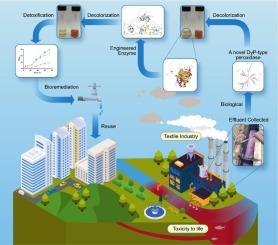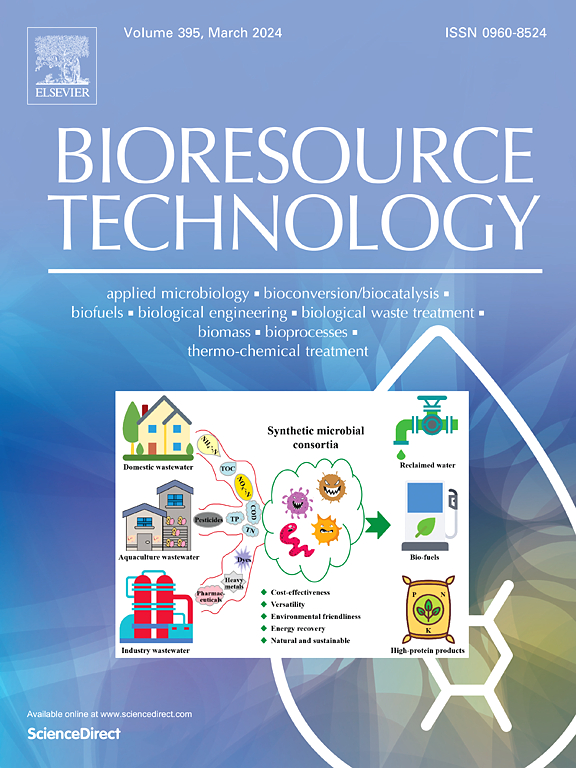一种新型农业短芽孢杆菌染料脱色过氧化物酶的表征及其在纺织废水脱毒中的应用。
IF 9
1区 环境科学与生态学
Q1 AGRICULTURAL ENGINEERING
引用次数: 0
摘要
纺织工业的含染料废水造成严重的生态和健康风险。在这里,我们从农业短芽孢杆菌中鉴定并表征了一种新的染料脱色过氧化物酶(BaDyP),该酶以其广泛的底物范围和催化稳定性而闻名。与酿酒酵母相比,大肠杆菌的外源表达具有更强的活性。重组BaDyP有效地脱色了七种结构不同的染料,去除率高达96.7 %(活性黑5,D240E变体),95.0 %(刚果红)和93.2 %(亚甲基蓝)。BaDyP对真实工业废水的脱色效率为78.1 %,经D240E突变体进一步提高至93.3 %,提高19.5 %。重要的是,BaDyP处理降低了废水毒性,正如微生物生长试验所证明的那样,并且通过FTIR验证了结构染料降解。总的来说,这些发现突出了BaDyP作为一种有前途的生物催化剂,可用于染料污染工业废水的可持续修复。本文章由计算机程序翻译,如有差异,请以英文原文为准。

Characterization of a novel Dye-Decolorizing peroxidase from Brevibacillus agri and its application in detoxification of textile industry wastewater
Dye-containing wastewater from the textile industry poses severe ecological and health risks. Here, we identified and characterized a novel dye-decolorizing peroxidase (BaDyP) from Brevibacillus agri, notable for its broad substrate range and catalytic robustness. Heterologous expression in Escherichia coli yielded superior activity compared to Saccharomyces cerevisiae. Recombinant BaDyP efficiently decolorized seven structurally diverse dyes, achieving removal rates of up to 96.7 % (Reactive Black 5, D240E variant), 95.0 % (Congo Red), and 93.2 % (Methylene Blue). BaDyP also decolorized authentic industrial effluent with 78.1 % efficiency, which was further enhanced to 93.3 % by the D240E mutant, representing a 19.5 % improvement. Importantly, BaDyP treatment reduced wastewater toxicity, as demonstrated by microbial growth assays, and structural dye degradation was validated by FTIR. Collectively, these findings highlight BaDyP as a promising biocatalyst for sustainable remediation of dye-contaminated industrial effluents.
求助全文
通过发布文献求助,成功后即可免费获取论文全文。
去求助
来源期刊

Bioresource Technology
工程技术-能源与燃料
CiteScore
20.80
自引率
19.30%
发文量
2013
审稿时长
12 days
期刊介绍:
Bioresource Technology publishes original articles, review articles, case studies, and short communications covering the fundamentals, applications, and management of bioresource technology. The journal seeks to advance and disseminate knowledge across various areas related to biomass, biological waste treatment, bioenergy, biotransformations, bioresource systems analysis, and associated conversion or production technologies.
Topics include:
• Biofuels: liquid and gaseous biofuels production, modeling and economics
• Bioprocesses and bioproducts: biocatalysis and fermentations
• Biomass and feedstocks utilization: bioconversion of agro-industrial residues
• Environmental protection: biological waste treatment
• Thermochemical conversion of biomass: combustion, pyrolysis, gasification, catalysis.
 求助内容:
求助内容: 应助结果提醒方式:
应助结果提醒方式:


